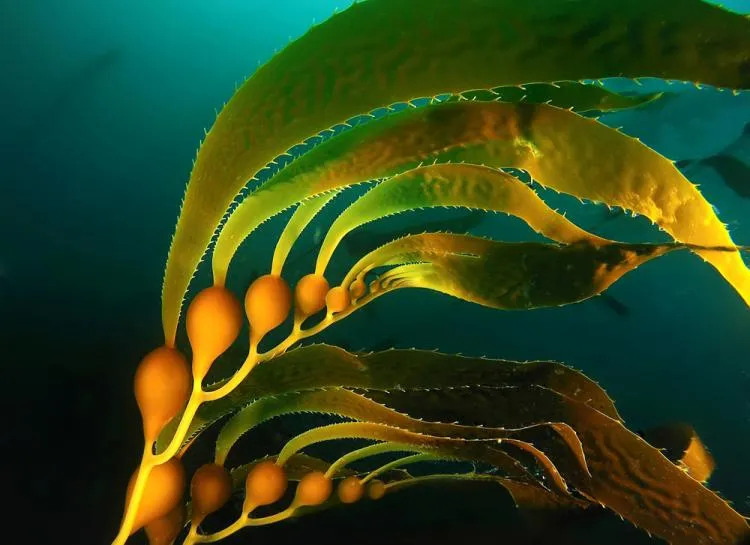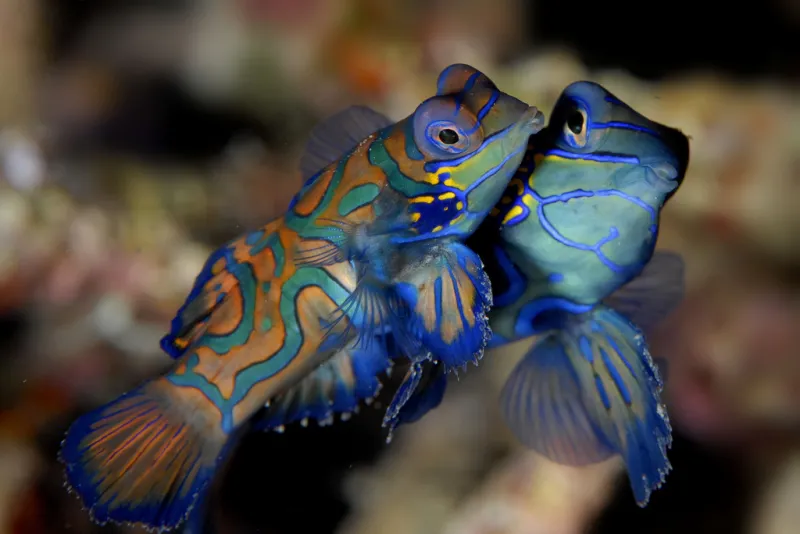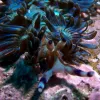"Two arrow crabs in a cup coral, lit from behind. It seemed to be a scene from a 1960s monster movie," wrote Carl Salonen of his winning image. Arrow crabs (Stenorhynchus seticornis) are small, spider-like crabs that live on coral reefs. Nocturnal animals, they leave their homes—often rocky crevices, sponges, corals, anemones or urchins—to forage for worms, detritus and algae at night.
Selections from the Brian Skerry Flickr Contest WInners

Spiders from Mars
Credit: Carl Salonen
Kelp Pennant
Credit: George Cathcart"Fronds of giant kelp, buoyed by their gas-filled pneumatocysts, wave like pennants in the current of Monterey Bay, California," wrote George Cathcart of his winning image. Giant kelp (Macrocystis pyrifera) is large, brown algae that grows in dense forests along coasts around the world. Long stalks anchor each plant to the seafloor, and they grow meters high like giant trees towards the surface. Kelp forest ecosystems are home to a variety of animals, including seals, sea lions, whales, sea otters, gulls, terns, snowy egrets, great blue herons, cormorants, and shore birds.

Eel, Embedded
Credit: Barry Fackler"A whitemouth moray eel emerges from the reef following a coral bloom in Honaunau Bay, Hawaii," wrote Barry Fackler of his winning image. Whitemouth morays (Gymnothorax meleagris) hide in the crevices of Indo-Pacific coral reefs with only their heads (and white mouths) emerging, mouths agape, to breathe and hunt crustaceans and fish.

Converted Pirate Fishing Vessel
Credit: Claire Fackler"Pirate fishing vessel converted to a home in Lembeh Strait off North Sulawesi, Indonesia," wrote Claire Fackler of her winning image.

Acrobats of La Paz, Mexico
Credit: David Henshaw"A juvenile California sea lion performing close to the camera. The speed and elegance of these creatures is really unmatched in the oceans," wrote David Henshaw of his winning image. California sea lions (Zalophus californianus) are social animals, forming groups of hundreds to thousands of animals that gather onshore to breed. Since the Marine Mammal Protection Act was passed in 1972, their population has swelled off the California coast, and is now estimated at nearly 300,000 animals.

Whip Coral Goby Portrait
Credit: Erwin Poliakoff"Macro shot of a whip coral goby, taken in Fiji during a trip to the Somosomo Strait," wrote Erwin Poliakoff of his winning image. Whip coral gobies (Bryaninops yongei) live on coral reefs throughout the Indo-Pacific, where they are found on a single species of coral: black wire coral (Cirrhipathes anguina).

Orangutan Crabs from Komodo Island
Credit: Indah Susanti"While Komodo Island, Indonesia is famous for its giant prehistoric lizard, its underwater also holds unique marine species to treasure. The orangutan crab is one of them. With its maximum size of two centimeters, it felt like searching for a needle in a haystack just to find him," wrote Indah Susanti of her winning image. Orangutan crabs (Achaeus japonicas) are covered in thin reddish hairs, and are frequently found living in bubble coral (Plerogyra sinuosa), as seen here.

Surfacing into a Sunset
Credit: Paul Cowell"This shot was taken during a dusk dive in Southern Leyte in the Philippines. I ended the dive with an amazing sunset," wrote Paul Cowell of his winning image. Southern Leyte is located in the Coral Triangle, an area of the Indo-Pacific which contains some of the most biodiverse coral reefs in the world.

Mandarinfish Duo
Credit: Erwin Poliakoff"We’re dancing in the moonlight; it’s caught us in its spotlight," wrote Mark Harris of his winning photograph. These beautiful mandarinfish (Synchiropus splendidus) are covered in bright blue, red, yellow and orange waves. What they lack, however, are traditional fish scales. Instead of your typical fish scales they are covered in a smelly mucus coating. It's possible that this mucus, which not only smells but also tastes bad, deters predators.

Santorini Island View from Fira
Credit: Rajeev Rajagopalan"Spectacular shades of blue in glorious sunshine with the nascent volcanic island in the backdrop," wrote Rajeev Rajagopalan of his winning image. The view from Fira, Santorini's capital city on the Aegean Sea, includes an active volcanic island formed by the same volcano that formed the Santorini islands.

Humpback Whales Going After Herring
Credit: Bo Eide"For the last few years, Norwegian herring have migrated to coastal waters outside Tromsø in the months between November and February, and humpbacks and orcas follow them to feast on the massive herring shoals. The humpbacks then continue on southwards, and some of them have been spotted as far south as the Kap Verde islands west of Mauretania," wrote Bo Eide of his winning image. Humpback whales (Megaptera novaeangliae) spend their summers feeding in cold, food-filled Arctic and Antarctic waters before swimming to warmer waters for the winter.

The Cat-Like Eyes of a Catshark
Credit: João Pedro Silva (Flickr)"A small-spotted catshark swims 30 meters deep in the Natural Reserve of Berlengas, Portugal. These are some of the most common sharks in the Atlantic coasts of Europe," wrote Joao Pedra Silva of his winning image. Like other catsharks, the small-spotted catshark (Scyliorhinus canicula) is named for the elongated, cat-like shape of its eyes. In a different way, all sharks have cat-like eyes. Like cats, sharks have a layer of reflective cells behind their retina (called the tapetum lucidum) that allows them to see better in dark and cloudy waters, in the deep sea or at night.

Satellite-Tagged Hawksbill Sea Turtle
Credit: Jake Levenson"As part of a site fidelity and migration study, this Hawksbill Sea Turtle has a small transmitter that sends its positions to orbiting satellites so that scientists can learn more of their habitat needs to better protect this endangered species," wrote Jake Levenson of his winning image. Satellite tags can track sea turtles like never before, helping with research on where newly hatched sea turtles go and how different populations hunt.

Valentinni's Sharpnose Puffer
Credit: Shawn Miller"This fish was extremely curious of my Sola modeling light. It continued to come up close to the camera. Location: Green Beach, Okinawa, Japan. Depth: 40ft on a day dive," wrote Shawn Miller of his winning image. Valentinni's sharpnose puffer (Canthigaster valentini) lives on Indo-Pacific coral reefs, where it shoals in groups of 10-100 puffers and feeds on algae and tunicates.

Serpent Pteraeolidia
Credit: Bill Kuiper"Blue Dragon nudibranchs are very common to the southeast coast of Australia and have a few color variations. Juveniles are white with blue rhinophores, and adults vary from dark purple to lavender to golden brown. I have seen these grow to a length of approximately 4 inches," wrote Bill Kuiper of his winning image. Like other aeolid nudibranchs, blue dragons (Pteraeolidia ianthina) steal stinging cells from their jellyfish prey and reuse them as defensive weapons.
















